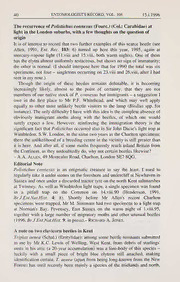Table Of Content40 ENTOMOLOGIST'S RECORD, VOL. 108 15.1.1996
The recurrence ofPolistichus connexus (Fourc.) (Col.: Carabidae) at
light in the London suburbs, with a few thoughts on the question of
origin
It is of interest to record that two further examples of this scarce beetle (see
Allen, 1991, Ent. Rec. 103: 6) turned up here this year, 1995, again at
mercury-vapour light (ll.viii and 15.viii, both warm nights). One of them
has the elytra almost uniformly testaceous, but shows no sign of immaturity;
the other is normal. (I should interpose here that for 1990 the total was six
specimens, not four - singletons occurring on 23.viii and 26.viii, after I had
my
sent in note.)
Though the origin of these beetles remains debatable, it is becoming
increasingly likely, almost to the point of certainty, that they are not
members of our native stock ofP. connexus but immigrants - a suggestion I
owe in the first place to Mr P.F. Whitehead, and which may well apply
equally to other most unlikely beetle visitors to the lamp {Bledius spp. for
instance). The only difficulty I have with this idea is the complete absence of
obviously immigrant moths along with the beetles, of which one would
surely expect a few. However, reinforcing the immigration theory is the
significant fact that Polistichus occurred also in Sir John Dacie's light trap at
Wimbledon, S.W. London, in the same two years as the Charlton specimens;
there the unlikelihood of a breeding centre in the vicinity is still greater than
it is here. And after all, if some moths frequently reach inland Britain from
the Continent, as they undoubtedly do, why not certain beetles likewise?
- A.A. Allen, 49 Montcalm Road, Charlton, London SE7 8QG.
Editorial Note
Polistichus connexus is an enigmatic creature to say the least. I used to
regularly take it under stones on the foreshore and undercliffat Newhaven in
Sussex and once under a discarded tractor tyre on the north Kent saltmarshes
at Twinney. As well as Wimbledon light traps, a single specimen was found
in a pitfall trap on the Common on 14.viii.90 (Henderson, 1991,
Br.J.Ent.Nat.Hist. 4: 8). Shortly before Mr Allen's recent Charlton
specimens were trapped, Mr M. Simmons had two specimens to a light trap
at Nomian's Bay, Pevensey, East Sussex on the warm night of l.viii.95,
together with a large number of migratory moths and other unusual beetles
(1996, Br.J.Ent.Nat.Hist. 9: in press).- Richard A. Jones.
A note on two clavicorn beetles in Kent
Triplax aenea (Schal.) (Erotylidae): among some beetle remnants submitted
to me by Mr K.C. Lewis of Welling, West Kent, from debris of starlings'
-
nests in his attic (a 20-year accumulation) was a fore-body of this species
luckily with a small piece of bright blue elytron still attached, making
identification certain. T. aenea (apart from being long-known from the New
Forest) has until recently been mainly a species of the midlands and north,
1
NOTES AND OBSERVATIONS 4
not found in the London and south-eastern districts; but within the last 15
years or more has spread into some of those areas, notably Berkshire (as at
Windsor, freely) and Surrey. However, the above would seem to be its first
occurrence in Kent, as far as records go.
Rhizophagus dispar (Payk.) (Rhizophagidae): I took a single example of this
under bark ofone of a number of larch poles dumped at the side of a path in
Joydens Wood, Bexley, West Kent (14.vi.l995). Being a not uncommon
species, it is rather strange that there appears to be no published record for
the county, and that R. dispar has not been previously noticed in its north-
west portion. As regards East Kent, Mr N.F. Heal tells me he finds it
regularly in several localities (extending to mid-Kent) but only from 1989 -
a fact suggesting a newcomer to the county. The case is not unlike that of
Triplax aenea (see above). Fowler (1889, Col. Brit. Isi. 3: 266) wrote of
Rhizophagus dispar: "it does not apparently occur in the London district
. . .
or the South". I took it in Hertfordshire in 1935, but it was not on the
original Windsor Forest list (Donisthorpe, 1939) though found there in later
years.- A.A. Allen, 49 Montcalm Road, Charlton, London SE7 8QG.
Unusual partial second broods ofmoths taken on the Isle ofWight in 1995
The year 1995 will be rememberd for having the warmest and driest summer
in the island since 1989. This was followed by the wettest September and the
warmest and sunniest October since records began.
Surprisingly there were fewer late partial second and third broods of
moths compared to 1989 and 1994. However, three species are worthy of
mention and these partial second brood examples are not mentioned in any
entomological literature.
1. Oligia strigilis (Linn.) 1 September, Shanklin (Lt. Cdr. J.M. Cheverton).
2. Apeira syringaria (Linn.) 1 October, Binstead (B.J. Wame).
3. Mimas tiliae (Linn.) 12 October, Freshwater (S.A. Knill-Jones).
All the above moths were taken at mercury vapour light.- S.A. Knill-Jones,
Roundstone, 2 School Green Road, Freshwater, Isle ofWight.
Melanitis leda L. (Lep.: Satyridae) crepuscular flight in Thailand
Frequenting shady habitats from southern Africa, across south-east Asia to
Australia and Japan, this is a familiar butterfly often disturbed from the leaf
litter on the ground by day to fly somewhat floppily to settle again a short
distance away. However, reference to its natural crepuscular flight is very
rarely mentioned, apart from its attraction to light.
In Pennington's Butterflies ofSouthern Africa (1978) is the statement "but
after sunset or on warm overcast days it flops about even in open glades"

